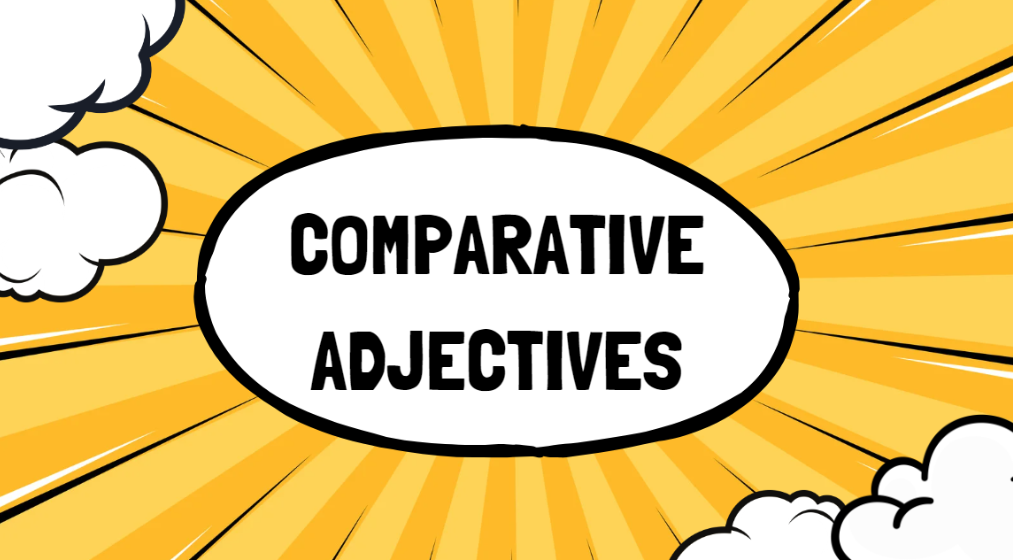Esta proposta de atividade de Língua Inglesa com base no DC/GO – Ampliado é destinada aos estudantes do 8º Ano do Ensino Fundamental Anos Finais.
Adjective comparatives are used to compare two or more people, things, or situations and indicate the difference between them. There are some basic rules for forming comparative adjectives in English.
Os adjetivos comparativos são usados para comparar duas ou mais pessoas, coisas ou situações e indicar a diferença entre elas. Existem algumas regras básicas para formar adjetivos comparativos em inglês.
LET’S ANSWER SOME QUESTIONS?

Disponível em:https://www.canva.com/design/DAFucOJncfU/TJEPv0so3iH1QAEYyoSyAA/edit , acesso em 09, Set. 2023
Leia o texto abaixo e responda as questões sobre o mesmo:
Adjective comparatives are used to compare two or more people, things, or situations and indicate the difference between them. There are some basic rules for forming comparative adjectives in English.
Short Adjectives:
Short adjectives usually have one or two syllables, such as “big,” “small,” “fast,” “slow,” among others. To form the comparative, you typically add “-er” to the adjective:
He is taller than his brother.
This car is faster than that one.
Long Adjectives:
Long adjectives have two or more syllables, such as “beautiful,” “interesting,” “expensive,” “difficult,” among others. To form the comparative, you usually add “more” before the adjective:
She is more beautiful than her sister.
Learning a new language is more difficult than I thought.
Exceptions (Irregular Comparatives):
Some adjectives have irregular comparative forms that do not follow the rules mentioned above. For example:
Good → Better
Bad → Worse
Far → Farther/Further
Superlatives:
In addition to comparatives, you can use superlatives to indicate the highest degree of a quality. For short adjectives, you typically add “-est” to the adjective:
She is the tallest person in the room.
This is the cheapest option.
For long adjectives, you usually use “the most” before the adjective:
He is the most interesting speaker at the conference.
That was the most challenging task I’ve ever faced.
Remember that the correct use of comparative adjectives is essential for expressing comparisons accurately in English. So, practice these rules to improve your communication skills.
QUESTION 1
Para que os adjetivos comparativos são usados?
a) Para descrever pessoas e lugares.
b) Para fazer perguntas em inglês.
c) Para comparar duas ou mais pessoas, coisas ou situações e indicar a diferença entre elas.
d) Para contar histórias em inglês.
QUESTION 2
Como são geralmente formados os comparativos de adjetivos curtos em inglês?
a) Adicionando “-est” ao adjetivo.
b) Adicionando “more” antes do adjetivo.
c) Adicionando “-er” ao adjetivo.
d) Adicionando “the most” antes do adjetivo.
QUESTION 3
Qual é a forma comparativa do adjetivo “good” (bom) em inglês?
a) Better
b) Gooder
c) More good
d) Best
QUESTION 4
Como os comparativos de adjetivos longos são geralmente formados em inglês?
a) Adicionando “-est” ao adjetivo.
b) Adicionando “more” antes do adjetivo.
c) Adicionando “-er” ao adjetivo.
d) Adicionando “the most” antes do adjetivo.
QUESTION 5
Qual é a forma superlativa do adjetivo “expensive” (caro) em inglês?
a) Expensiver
b) More expensive
c) Expensivest
d) The most expensive
QUESTION 6
desembarace as letras das palavras abaixo e forme o comparativo dos adjetivos a seguir:
a) Good – R-B-E-T-T-E-T →
b) Strong – R-O-S-T-R-G-E-N →
c) Big- G-G-B-I-R-E →
d) Dry – R-E-D-I-R →
QUESTION 8
Encontre os adjetivos na cruzadinha abaixo:
1 – Comparativo de bad
2 – Comparativo de good
3 – Comparativo de heavy
4 – Comparativo de happy
5 – Comparativo de tall
6 – Comoparativo de strong
| Autoria: | Proª Drª Sueidy Lourencio |
| Formação: | Letras Português / Inglês – Doutorado em Educação |
| Componente Curricular: | Língua Inglesa |
| Habilidade: | (EF08LI15-A) Utilizar as formas comparativas e superlativas de adjetivos,comparando qualidades e quantidades em interações discursivas. |
| Referencial Teórico: | MAKAR, Barbara W. Primary Phonics. 1. ed. Chicago: Modern Curriculum Press, 2018. KOUSTAFF, Lesley. Oxford Discover. 2. ed. v. 1. Oxford: Oxford University Press, 2018. KOUSTAFF, Lesley. Oxford Discover. 2. ed. v. 2. Oxford: Oxford University Press, 2018. Disponível em:https://www.canva.com/design/DAFucOJncfU/TJEPv0so3iH1QAEYyoSyAA/edit , acesso em 09, Set. 2023 |
